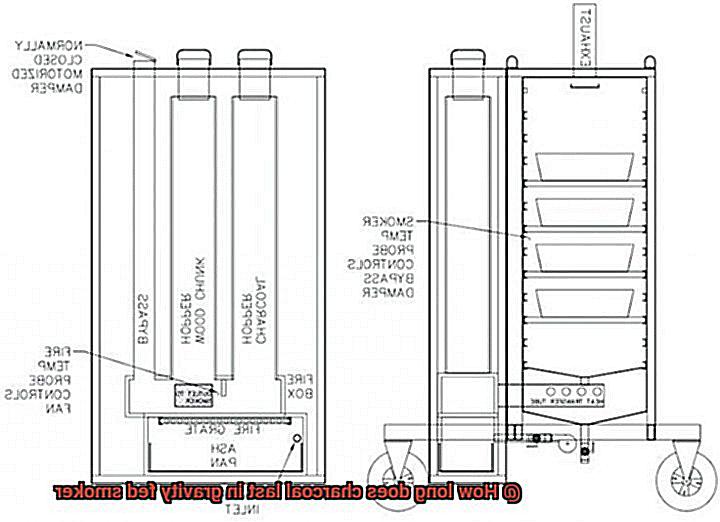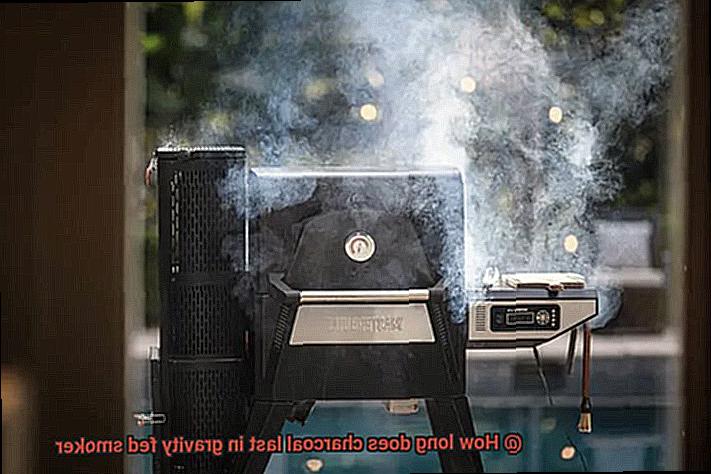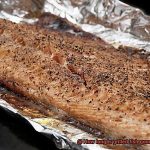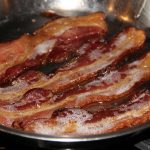Are you planning a backyard BBQ bash or a camping trip with your loved ones? If the answer is yes, then you might be pondering how long charcoal lasts in a gravity-fed smoker. Well, don’t worry because we’ve got you covered.
Smoking meat with charcoal is undoubtedly one of the most popular cooking methods out there. However, nailing the perfect timing when it comes to cooking large cuts of meat can be challenging. That’s where gravity-fed smokers come in. These smokers use charcoal as the heat source and are designed to be efficient and user-friendly.
But here’s the million-dollar question: How long does charcoal last in a gravity-fed smoker? The answer to this question depends on several factors such as the size of the smoker, the amount of charcoal used, and the cooking temperature. In this blog post, we will delve into these factors in detail and address all your queries about how long charcoal lasts in a gravity-fed smoker.
So if you’re itching to impress your guests with mouth-watering smoked meats, keep reading. We’ll provide you with all the relevant information that will help you become an expert at using a gravity-fed smoker.
Contents
What is a Gravity Fed Smoker?
If you’re looking to elevate your outdoor cooking game, a Gravity Fed Smoker might be just what you need. But what exactly is a Gravity Fed Smoker and why are they so popular among BBQ enthusiasts?
At its core, a Gravity Fed Smoker is a type of smoker that uses charcoal or wood as fuel and relies on the principle of gravity to feed the fuel into the cooking chamber. Unlike other types of smokers that require constant attention and adjustments throughout the cooking process, a Gravity Fed Smoker allows for consistent temperature control and prolonged cooking times with minimal effort.
The design of a Gravity Fed Smoker includes a firebox located at the bottom of the smoker which holds the charcoal or wood, and a hopper above it that feeds the fuel into the cooking chamber through a chute or tube. The hopper is typically filled with enough charcoal to last for several hours, depending on the size of the smoker and the desired cooking temperature.
One of the key advantages of a Gravity Fed Smoker is its ability to maintain a steady temperature throughout the entire cooking process. This is achieved by regulating the amount of fuel that enters the cooking chamber and controlling airflow. As charcoal burns, it creates ash which falls through a grate at the bottom of the firebox, allowing fresh charcoal to take its place and ensuring a continuous supply of heat.
Gravity Fed Smokers come in various sizes and shapes, from small backyard models to large commercial units. They are ideal for smoking brisket, ribs, pork shoulder, and other meats that require slow cooking at low temperatures. However, it’s important to keep in mind that how long your charcoal lasts depends on factors such as the size of your smoker, cooking temperature, and weather conditions.

To maximize your smoker’s efficiency and get the most out of your fuel, consider using dense briquettes rather than lump charcoal, as they tend to burn at a lower temperature and slower rate. Some models even come with features such as digital controllers and automatic feeders to make temperature regulation and fuel management even easier.
What Type of Charcoal Should be Used?
Then let’s discuss the critical factor that can make or break your smoking experience – choosing the right type of charcoal.
Quality is paramount when selecting your charcoal. Don’t settle for low-quality charcoal that burns too quickly or produces too much ash, and instead, invest in high-quality lump charcoal made from pure hardwood with no additives or fillers. Trust us; it’s worth the investment for the flavor payoff.
Size also plays a crucial role in your smoking experience. Larger pieces of charcoal will burn slowly and evenly, providing a consistent heat source for your food. This is especially vital if you plan on extended cook times, like smoking a brisket or pork shoulder.
Another critical consideration is the type of wood used in your charcoal. Different woods produce different flavors when used as charcoal. Hickory and mesquite are excellent options for a strong smoky flavor, while oak and maple provide a more subtle taste. Consider your personal preference and the type of food you’re cooking when choosing your wood type.
Proper storage is also essential to prolonging your charcoal’s lifespan. Keep it dry and cool in a place away from moisture and direct sunlight to prevent it from absorbing moisture and deteriorating quickly.
How Does the Size of the Smoker Affect Charcoal Life?
First and foremost, the size of your smoker plays a significant role in the amount of charcoal you’ll need. A larger smoker requires more charcoal to maintain a consistent temperature over an extended period of time. So, if you have a massive gravity-fed smoker, be prepared to use a lot more charcoal than if you have a smaller one.
However, there’s more to it than just the amount of charcoal. The size of your smoker can also affect airflow and ventilation, which can impact how long your charcoal lasts. A larger smoker may have more air flowing through it, causing the charcoal to burn faster and require more frequent refilling. On the other hand, if your smoker is too small and doesn’t have enough airflow, your charcoal may not burn as efficiently, leading to longer-lasting but potentially unnecessary burning.
Moreover, the size of your charcoal also matters. Larger pieces of charcoal burn slower and last longer than smaller ones. Therefore, if you’re looking to extend the life of your charcoal in a larger smoker, using larger chunks may be beneficial.
To maximize the life of your fuel source in a gravity-fed smoker, you need to find the right balance between smoker size, airflow, and charcoal size. Experimentation is key in determining what works best for your specific setup. You can try out different amounts and sizes of charcoal until you find the perfect combination that suits your smoking needs.
How Does Cooking Temperature Affect Charcoal Life?
The cooking temperature is a key factor that can affect the lifespan of charcoal in a smoker.
Firstly, let’s discuss the basics. The higher the cooking temperature, the faster the charcoal will burn out. This is due to an increase in airflow inside the smoker, causing the charcoal to burn more quickly and reducing its lifespan. On the other hand, cooking at a lower temperature will cause the charcoal to burn slowly, extending its lifespan.
But it’s not just temperature that matters. Different types of charcoal have different burning rates and lifespans. Lump charcoal, for example, burns hotter and faster than briquettes, resulting in a shorter lifespan. If you’re using lump charcoal, be sure to monitor temperatures closely to ensure it doesn’t burn out too quickly.
The amount of charcoal you use also plays a significant role in its lifespan. While using more charcoal will typically make it last longer, it’s essential not to use too much. Using too much can lead to temperature spikes inside the smoker, causing the charcoal to burn out more quickly.
So what’s the secret to maximizing your charcoal’s lifespan? It all comes down to maintaining a steady cooking temperature. This can be achieved by adjusting the airflow inside the smoker or by adding more fuel when necessary. Additionally, investing in a high-quality smoker that retains heat well can also help extend your charcoal’s lifespan.
What is the Average Lifespan of Charcoal in a Gravity Fed Smoker?
One of the most critical factors to consider is the lifespan of the charcoal in your gravity fed smoker. Charcoal is the primary fuel source for a smoker, and it’s important to know how long it will last to plan for your smoking sessions adequately.
The average lifespan of charcoal in a gravity fed smoker varies depending on several factors. Quality charcoal is key, as higher quality charcoal generally burns hotter and longer, thus lasting longer in a smoker than lower quality charcoal. Investing in high-quality charcoal will help ensure that your charcoal lasts longer.
The temperature at which your smoker is running also impacts the lifespan of your charcoal. Running your smoker at a higher temperature will cause the charcoal to burn faster, resulting in a shorter lifespan. In contrast, running your smoker at a lower temperature will cause the charcoal to burn slower and last longer. Monitoring your smoker’s temperature is essential if you want to extend the lifespan of your charcoal.
So, how long does charcoal last in a gravity fed smoker? On average, most charcoal lasts between 8-12 hours in a gravity fed smoker when running at a steady temperature. However, this can vary depending on the factors mentioned above. Keeping an eye on your charcoal levels during smoking sessions is always a good idea to ensure that you have enough fuel to last throughout the entire session without having to add more charcoal.
Tips to Make Charcoal Last Longer
If you’re a fan of smoking meats, you know that one of the biggest concerns is how long the charcoal will last in your gravity fed smoker. The good news is that there are several tips and tricks you can use to make your charcoal last longer and ensure that your meat is cooked to perfection.
Invest in high-quality charcoal
Not all charcoal is created equal. To ensure that your charcoal lasts as long as possible, look for high-quality charcoal made from hardwoods. This type of charcoal burns hotter and longer than cheaper alternatives, which means you’ll need less of it overall.
Control the airflow
One of the most important factors in making your charcoal last longer is controlling the airflow in your smoker. With a gravity fed smoker, this is typically done by adjusting the damper or vent on the side of the unit. By restricting the amount of oxygen that reaches your charcoal, you can slow down the rate at which it burns and ensure that it lasts for as long as possible.
Minimize openings
Every time you open your smoker, you let heat and smoke escape. To minimize the amount of fuel you need to use, try to avoid opening the lid too often or for too long. When you do need to open it, work quickly to avoid losing too much heat.
Add charcoal strategically
Rather than dumping all of your charcoal in at once, add it gradually throughout the cooking process as needed. This will help ensure that you always have enough fuel without wasting any.
Use wood chunks or chips
Adding wood chunks or chips to your smoker can also help extend the life of your charcoal. The wood will smolder and release smoke, which not only gives your food a delicious smoky flavor but also helps keep the temperature stable and reduces the amount of charcoal needed.
The Pros and Cons of Using Lump Charcoal vs Briquettes
With so many options available, it can be overwhelming to decide which one to use in your gravity fed smoker. Let’s explore the pros and cons of using lump charcoal vs briquettes in a gravity fed smoker.
Lump charcoal is made from natural hardwood that is burned down into charcoal. Although it is more expensive than briquettes, it burns hotter and faster. This means that you will need to add more charcoal to your smoker more frequently, but it also produces less ash than briquettes, making clean-up easier.
On the other hand, briquettes are made from compressed sawdust and other materials. They are cheaper and more widely available than lump charcoal, but they don’t burn as hot as lump charcoal and produce more ash. This can be a downside when using a gravity fed smoker.
So, what are the pros and cons of using lump charcoal vs briquettes in a gravity fed smoker? Let’s break it down:
Pros of using lump charcoal
- Made from natural hardwood
- Burns hotter and faster than briquettes
- Produces less ash than briquettes
Cons of using lump charcoal
- More expensive than briquettes
- Needs to be added more frequently to the smoker
Pros of using briquettes
- Cheaper and more widely available than lump charcoal
- Burns longer than lump charcoal
- Consistent size and shape makes it easy to stack in the smoker
Cons of using briquettes
- Doesn’t burn as hot as lump charcoal
- Produces more ash than lump charcoal
- Made from compressed sawdust and other materials
Ultimately, choosing between lump charcoal and briquettes comes down to personal preference. If you’re willing to spend a little extra money and don’t mind adding more charcoal to your smoker more frequently, then lump charcoal might be the way to go.
However, if you’re looking for a cheaper and more widely available option that burns longer, then briquettes might be the better choice.
Keep in mind factors such as cost, heat output, ash production, and how often you’ll need to add more charcoal before making your decision.
Conclusion
In conclusion, smoking meat with charcoal is a beloved cooking method that requires precision and patience. Luckily, gravity-fed smokers offer an efficient and user-friendly option for outdoor cooking enthusiasts. However, the longevity of your charcoal in a gravity-fed smoker depends on several factors, including the size of your smoker, the amount of charcoal used, and the cooking temperature.
To get the most out of your fuel source and maximize efficiency, invest in high-quality lump charcoal made from pure hardwood with no additives or fillers. Alternatively, dense briquettes can burn at a lower temperature and slower rate than lump charcoal.
Your smoker’s size is also an important consideration when it comes to how long your charcoal lasts. A larger smoker requires more fuel to maintain a consistent temperature over a longer period. Additionally, the cooking temperature directly affects your fuel’s lifespan. Higher temperatures will cause your charcoal to burn faster and result in shorter cook times.
By controlling airflow, minimizing openings, strategically adding charcoal throughout the cook time, and incorporating wood chunks or chips for added flavor, you can extend your fuel source’s life in a gravity-fed smoker. Ultimately, choosing between lump charcoal and briquettes depends on personal preference based on cost, heat output, ash production, and frequency of refueling.






